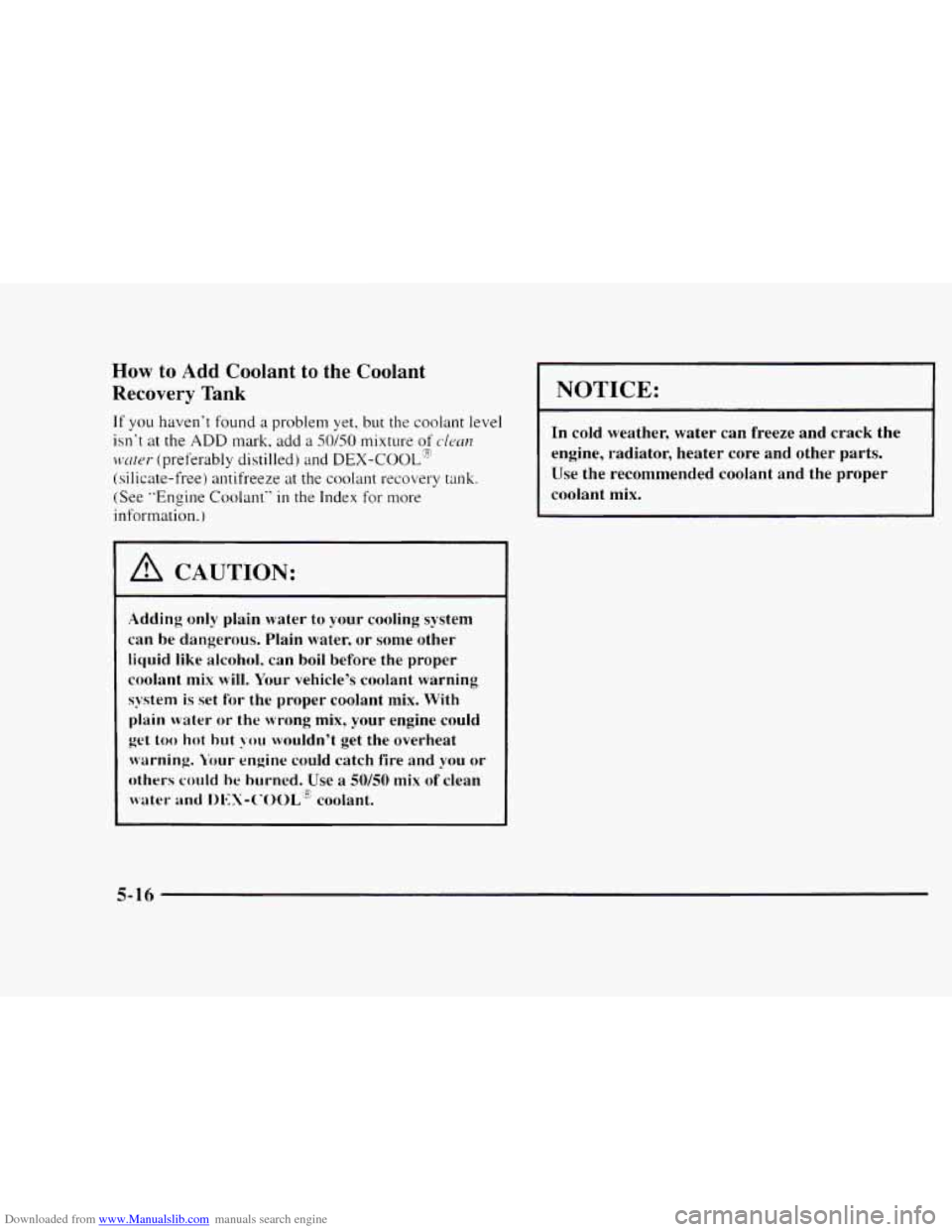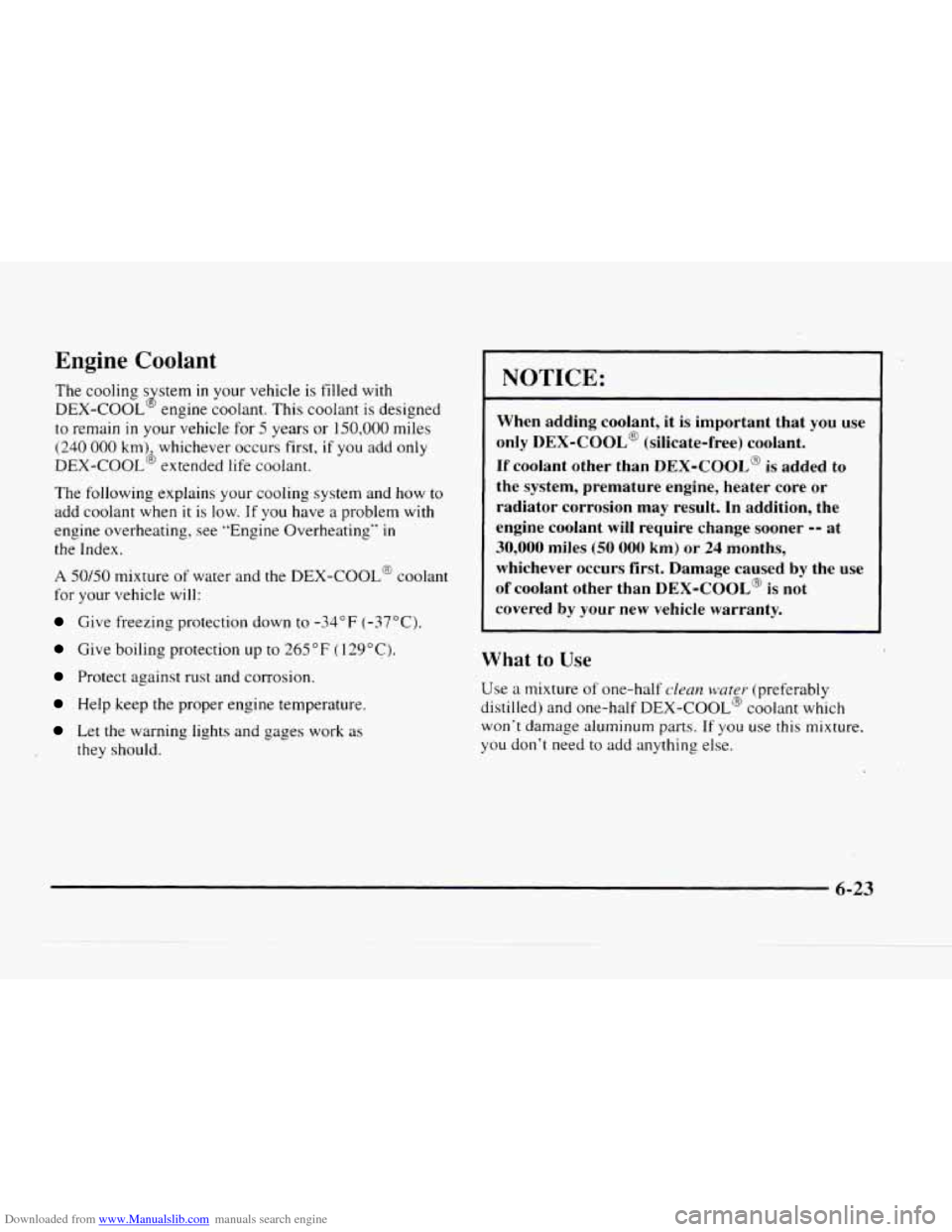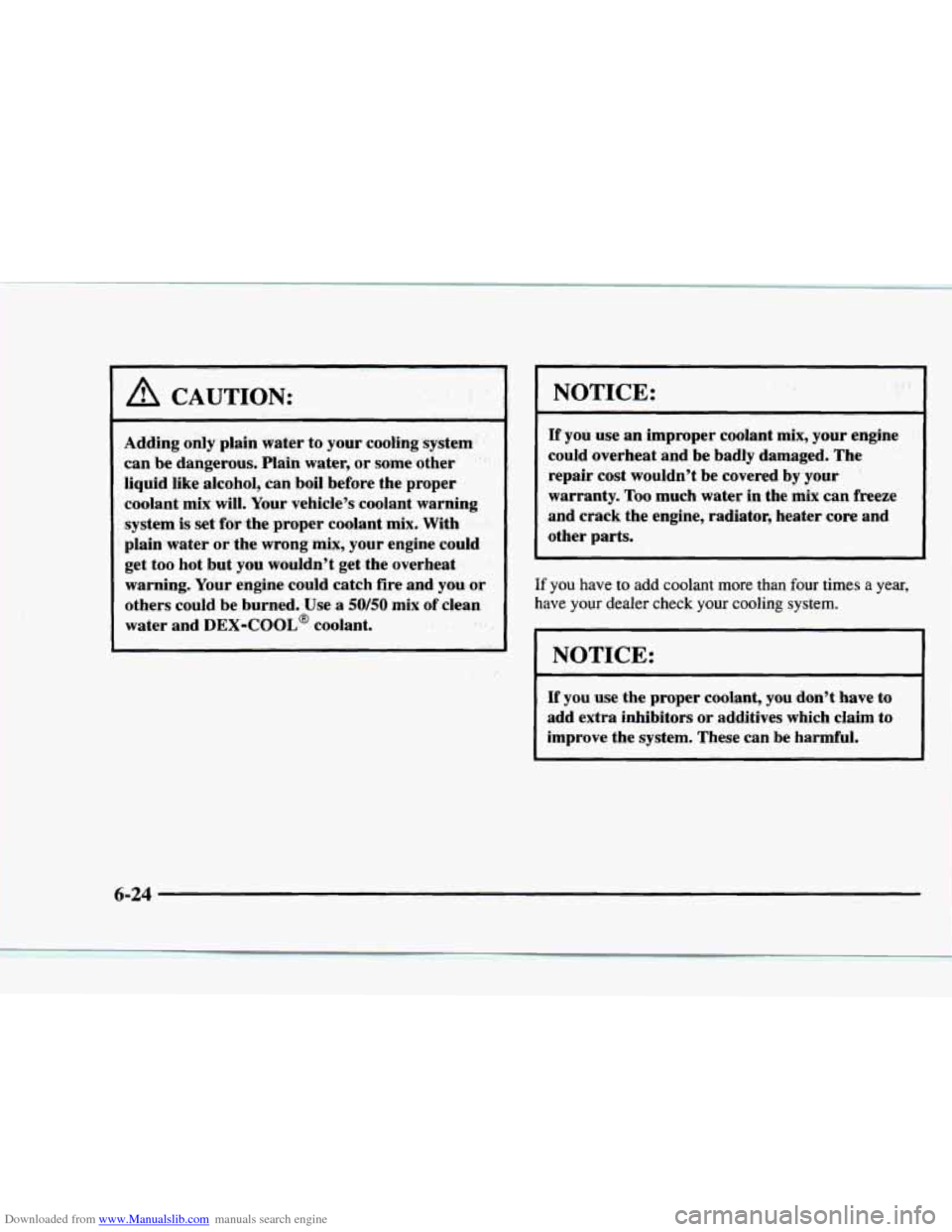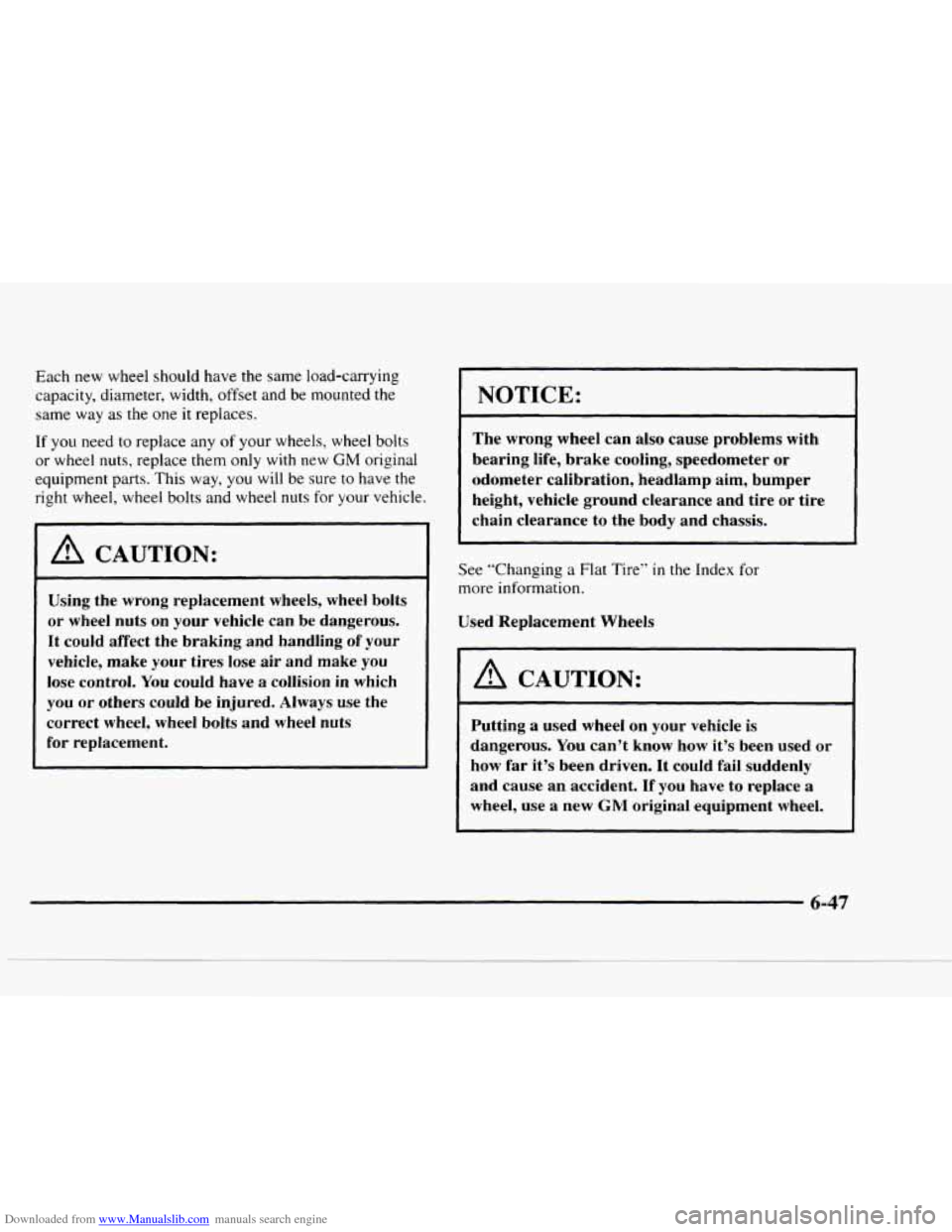Page 233 of 402

Downloaded from www.Manualslib.com manuals search engine How to Add Coolant to the Coolant
Recovery Tank
If you haven‘t found a problem yet, but the coolant level
isn‘t at the ADD mark, add a SO/SO mixture of clenrz
wter (preferably distilled) and DEX-COOL”
(silicate-free) antifreeze at the coolant recovery tank.
(See ”Engine Coolant”
in the Index for more
information.)
A CAUTION:
Adding only plain water to your cooling system
can be dangerous. Plain water, or some other
liquid like alcohol, can boil before the proper
coolant mix
will. Your vehicle’s coolant warning
system
is set for the proper coolant mix. With
plain water
or the wrong mix, your engine could
get too hot but >‘ou wouldn’t get the overheat
warning. k‘our
engine could catch fire and you or
others
could he hurned. Use a 50/50 mix of clean
water and DKX-CWOL” coolant.
NOTICE:
In cold weather, water can freeze and crack the
engine, radiator, heater core and other parts.
Use the recommended coolant and the proper
coolant
mix.
5-16
Page 234 of 402
Downloaded from www.Manualslib.com manuals search engine 4
I A CAUTION:
You can be burned if you spill coolant on hot
engine parts. Coolant contains ethylene glycol
and it
will burn if the engine parts are hot
enough. Don’t spill coolant on
a hot engine.
When the coolant in the coolant recovery tank is at the
ADD mark, start your vehicle.
If the overheat warning continues, there’s one more
thing
you can try. You can add the proper coolant mix
directly to the radiator, but be sure the cooling system is
cool before you do it.
5-17
Page 235 of 402
Downloaded from www.Manualslib.com manuals search engine A CAUTION:
Steam and scalding liquids from a hot cooling
system can blow out and burn you badly. They
are under pressure, and
if you turn the radiator
pressure cap
-- even a little -- they can come out
at high speed. Never turn the cap when the
cooling system, including the radiator pressure
cap,
is hot. Wait for the cooling system and
radiator pressure cap to
cool if you ever have to
turn the pressure cap.
5-18
Page 236 of 402
Downloaded from www.Manualslib.com manuals search engine How to Add Coolant to the Radiator
1. You can remove the pressure cap when the cooling
system, including the pressure cap and upper radiator
hose, is no longer hot. Turn the pressure cap slowly
counterclockwise
until it first stops. (Don't press
down while turning the pressure cap.)
If you hear a hiss. wait for that to stop. A hiss means
there is still some pressure left.
2. Then keep turning the pressure cap, but now push
down as you turn it. Remove the pressure cap.
5-19
Page 239 of 402

Downloaded from www.Manualslib.com manuals search engine Engine Fan Noise
This vehicle has a clutched engine cooling fan. When
the clutch
is engaged, the fan spins faster to provide
more air
to cool the engine. In most everyday driving
conditions, the clutch
is not engaged. This improves
fuel economy and reduces fan noise. Under heavy
vehicle loading, trailer towing and/or high outside
temperatures. the fan speed increases when the clutch
engages.
So you may hear an increase in fan noise. This
is normal and should
not be mistaken as the
transmission slipping or making extra shifts.
It is merely
the cooling system functioning properly. The
fa11 will
slow down when additional cooling is not required and
the clutch disengages.
You may also hear this fan noise when you start the
engine.
It will go away as the fan clutch disengages.
If a Tire Goes Flat
It's unusual for a tire to "blow out" while you're driving.
especially
if you maintain your tires properly. If air goes
out of a tire, it's much Inore likely to leak out slowly.
But if you should ever have ;I "blowout." here are a few
tips about what to expect and what to do:
If a front tire fails. the flat tire will create a drag that
pulls the vehicle toward that side. Take your foot off the
accelerator pedal and grip the steering wheel firmly.
Steer
to maintain lane position. and then gently brake to
a stop well out of the traffic lane.
A rear blowout. particularly on a curve. acts much like a
skid and may require the same correction you'd use in a
skid. In any rear blowout. remove your foot from the
xcelerator pedal. Get the \,chicle under control by
steering the way you want the vehicle to go. It may be
\.cry bunlpy and noisy. but you can still steer. Gently
brake
to a stop -- well off the road if possible.
5-22
Page 278 of 402

Downloaded from www.Manualslib.com manuals search engine Engine Coolant
The cooling s stem in your vehicle is filled with
DEX-COOL engine coolant. This cooIant is designed
to remain in your vehicle for 5 years or 150,000 miles
(240
000 km) whichever occurs first, if you add only
DEX-COOL’ extended life coolant.
The following explains your cooling system and
how to
add coolant when
it is low. If you have a problem with
engine overheating, see “Engine Overheating”
in
the Index.
A 50/50 mixture of water and the DEX-COOL@ coolant
for your vehicle will:
Give freezing protection down to -34°F (-37°C).
Give boiling protection up to 265 “F ( 129°C).
Protect against rust and corrosion.
Help keep the proper engine temperature.
Let the warning lights and gages work as
J
they should.
NOTICE:
When adding coolant, it is important that you use
only
DEX-COOL@ (silicate-free) coolant.
If coolant other than DEX-COOL@ is added to
I the system, premature engine, heater core or
radiator corrosion may result. In addition, the
engine coolant
will require change sooner -- at
30,000 miles (50 000 km) or 24 months,
whichever occurs first. Damage caused
by the use
of coolant other than DEX-COOL@ is not
covered
by your new vehicle warranty.
What to Use
Use a mixture of one-half clean water (preferably
distilled) and one-half DEX-COOL@ coolant which
won’t damage aluminum parts.
If you use this mixture.
you don’t need to add anything else.
6-23
Page 279 of 402

Downloaded from www.Manualslib.com manuals search engine A CAUTION:
Adding only plain water to your cooling system
can be dangerous. Plain water, or some other
liquid like alcohol, can boil before the proper
coolant mix will. Your vehicle’s coolant warning
system is set for the proper coolant mix. With
plain water or the wrong mix, your engine could
get too hot but you wouldn’t get the overheat
warning. Your engine could catch fire and you or
others could be burned.
Use a 5060 mix of clean
water and
DEX-COOL@ coolant.
NOTICE:
If you use an improper coolant mix, your engine
could overheat and be badly damaged. The
repair cost wouldn’t be covered
by your
warranty.
Too much water in the mix can freeze
and crack the engine, radiator, heater core and
other parts.
If you have to add coolant more than four times a year,
have
your dealer check your cooling system.
I NOTICE:
If you use the proper coolant, you don’t have to
add extra inhibitors
or additives which claim to
improve the system. These can be harmful.
6-24
Page 302 of 402

Downloaded from www.Manualslib.com manuals search engine Each new wheel should have the same load-carrying
capacity, diameter, width,
offset and be mounted the
same way as the one it replaces.
If you need to replace any of your wheels, wheel bolts
or wheel
nuts, replace them only with new GM original
equipment parts. This way, you will be sure
to have the
right wheel, wheel bolts and wheel nuts for your vehicle.
I A CAUTION:
NOTICE:
The wrong wheel can also cause problems with
bearing life, brake cooling, speedometer or
odometer calibration, headlamp aim, bumper
height, vehicle ground clearance and tire
or tire
chain clearance to the body and chassis.
Using the wrong replacement wheels, wheel bolts
or wheel nuts
on your vehicle can be dangerous.
It could affect the braking and handling of your
vehicle, make your tires lose
air and make you
lose control. You could have a collision in which
you or others could be injured. Always use the
correct wheel, wheel bolts and wheel nuts
for replacement.
See “Changing a Flat Tire” in the Index for
more information.
Used ’Replacement Wheels
I A CAUTION:
Putting a used wheel on your vehicle is
dangerous. You can’t know how it’s been used or
how
far it’s been driven. It could fail suddenly
and cause an accident.
If you have to replace a
wheel, use a new
GM original equipment wheel.
6-47